 Human beings are social creatures and our lives depend on other humans. We are born unable to care for ourselves. We develop and learn about the world around us through others. Our connections to others are key not only our survival, but also to our happiness and the success of our careers.
Human beings are social creatures and our lives depend on other humans. We are born unable to care for ourselves. We develop and learn about the world around us through others. Our connections to others are key not only our survival, but also to our happiness and the success of our careers.
And being social creatures comes the need to interact with others to reassure ourselves that we are liked, admired, respected; and noticed.
Then on April, 30th, 1993, it was announced that the World Wide Web would be free to everyone and the rest is history. Since then, the introduction of social network sites such as MySpace, Facebook, Twitter and even AOL in the beginning, to name a few, has transformed the way we communicate.
Along with the Internet Social media will probably go down as one of the major influencers of every generation since the Baby Boom generation and take its place as one of the wonders of modern time.
Between 2000 and 2002 the number of users on the internet grew a staggering 566.4% Nowhere else nor at any time in history has there been a forum even close to the scale of the World Wide Web.
WORLD INTERNET USAGE AND POPULATION STATISTICS
June 30, 2012
World Regions
Population
( 2012 Est.)
|
Internet Users |
Internet Users |
Penetration |
Growth |
Users % |
||
|
1,073,380,925 |
4,514,400 |
167,335,676 |
15.6 % |
3,606.7 % |
7.0 % |
|
|
3,922,066,987 |
114,304,000 |
1,076,681,059 |
27.5 % |
841.9 % |
44.8 % |
|
|
820,918,446 |
105,096,093 |
518,512,109 |
63.2 % |
393.4 % |
21.5 % |
|
|
223,608,203 |
3,284,800 |
90,000,455 |
40.2 % |
2,639.9 % |
3.7 % |
|
|
348,280,154 |
108,096,800 |
273,785,413 |
78.6 % |
153.3 % |
11.4 % |
|
|
593,688,638 |
18,068,919 |
254,915,745 |
42.9 % |
1,310.8 % |
10.6 % |
|
|
35,903,569 |
7,620,480 |
24,287,919 |
67.6 % |
218.7 % |
1.0 % |
|
|
7,017,846,922 |
360,985,492 |
2,405,518,376 |
34.3 % |
566.4 % |
100.0 % |
With all this connectivity we are now being faced with the loss of our privacy being subjected to Government agencies and even Employers spying on us and collecting information. By putting it all out there for everyone to see one should expect and understand that they are relinquishing their right to privacy to a large extent.
We use all this technology to interact with friends and family, to get the latest news and entertainment, and to research things we want to know about. It was only a matter of time before business saw the opportunities that Social Media offered.
Business saw the opportunity that getting involved with social Media would open up a huge potential resource. Social Media presented Business with ways to reach people in ways that were never possible with other forms of media. It allowed them to put a face to their business and to identify them in new ways.
But this new social medium also comes with risks that if they are not socially responsible in their advertising and communications or have any kind of misstep the consequences could be very costly.
It is all boils down to how you use it to your advantage or disadvantage. We are influenced by, and we are able to influence, people who we know as well as people we never met. We need to look at what social networks hold our interests and decided if the people we are interacting with are the people we want shaping our lives and careers.
We can influence others and gain recognition by posting blogs, getting involved in discussions, participate in forums and even help people by being a tutor online at a language site or any of the many sites available on the World wide Web.
Social interaction can open doors to job or other opportunities. You can meet like-minded people and have discussions with people who can give you new perspectives. The possibilities for whatever we are looking for or want to accomplish socially are limitless.
In the end, we need to take responsibility for how we act socially on the internet because in the end the internet as a social whole will make the final judgment on how it reacts to, responds to and accepts to what it is being disseminated.
Written By Bill Cosgrove
DealerNet Services
Why Your Company's Customer Experience May Be Falling Behind
Tags: Regular readers of the Help Scout blog know that we love research and statistics.
Regular readers of the Help Scout blog know that we love research and statistics.I recently came across new consumer data from Forrester, a global research and advisory firm specializing in the customer experience, which features a number of shocking claims.

While many companies think that they are leading the charge with service quality and creating an innovative customer experience, the numbers tell quite a different story … in the eyes of customers, most companies are falling flat.

Today we are going to scrutinize what most companies are doing incorrectly and highlight how to fix these problems.
Avoid reading at your own risk, since we’ll be putting the spotlight on why less than 10 percent of companies are receiving a passing grade from customers!

1. Too Much Imitation, Not Enough Innovation When it comes to delivering an outstanding customer experience, far too many companies are content with simply “keeping up with the Joneses.â€
In the most recent Forrester survey of 100 customer experience professionals, 58 percent of respondents said that their firms drive customer experience innovation by closely watching what their direct competitors are doing, and a full 72 percent look to outright copy companies in other industries.

The embarrassing amount of copying that is going on has been recently pointed out by research analyst Kerry Bodine, and it’s the reason why “good enough†is the disappointingly low bar to which many companies now strive:
Citibank wanted to copy the Apple store so badly that it actually hired the same architects responsible for the Apple store concept to design its bank of the future. Imitation may be the highest form of flattery—but it's not innovation.†There is a lot more risk in copying your competitors than you may think. First of all, they might not know exactly what they are doing; even if they do, it doesn’t mean that what works for them will work for you.

Even worse, many companies are not seeking to imitate the industry leaders, or those businesses most known for their customer experience. According to the Forrester analysis published in the Harvard Business Review:

…13% of companies said that they'll settle for nothing less than having the best customer experience across every industry—in other words, these companies want to be the next Apple, Disney, or Zappos.â€Ã¢Ã‚۬ That leaves a whopping 87 percent of companies who will settle for less than the best when it comes to their customer experience!
We’ve previously shown you the data on how 80 percent of companies believe they are delivering superior service to their competitors. In light of these admissions, it’s easy to see why in reality they are falling flat. Consider this startling statistic from the Forrester survey:

In 2013, only 8% of the companies surveyed received a top grade from their customers for their customer experience.
The problem: Many companies think that they are leading the charge in customer experience innovation, but in reality they are okay with being just “okay.â€Ã¢Ã‚۬
This sort of thinking is dangerous. You’ll never be able to convince customers to switch to your company by simply matching the passable service quality of your competitors.
The image below offers a supporting example (because here at Help Scout, we’re nothing if not honest!) of this fact. Many of our prospective customers who are currently with a competitor stay not because they are blown away by what they are paying for, but because their current experience is “good enough.â€Ã¢Ã‚۬
Since the majority of companies are failing to deliver when it comes to customer expectations, following their lead will likely result in a vicious cycle of the blind leading the blind. Being at the head of the pack means turning your back to them.

2. Using Technology as a Crutch A great customer experience is still reliant on memorable employee-to-customer interactions. In other words, it’s still about the people. (Breaking news: The sun is hot!)

Why, then, do so many companies rely on technology as the crutch for delivering their service?

Keep in mind that technology alone isn’t the culprit here; the issue is using technology without considering the needs of your customers (“technology for technology’s sakeâ€), which can end in disaster.
A multinational auto insurance company provides an excellent example here. The company invested heavily in a new mobile app that would connect customers to a call center agent in an emergency.
The idea looked good on paper, but it failed to account for the fact that drivers wouldn’t preemptively download the app in anticipation of getting into a car crash … and they had more pressing things on their minds than browsing an app store once an accident occurred.
The result: Another so-called innovation that failed to produce business results.

The lesson here is that new ways to improve the customer experience must be founded in differentiation and their ability to generate long-term value for the business.
Simply being innovative or on-trend won’t result in real improvements in doing business with your company.
Remember why this app fell flat, and be sure that the improvements you make are geared toward resolving the issues that actually plague your customers.
How to Fix These Problems Bodine has outlined a few smart, applicable strategies for putting some of the worries discussed above to bed.

Below are her top three tips for avoiding a stagnant, misguided customer experience.

Tip #1 Rethink Opportunities Before Moving Academic research has shown that when it comes to brainstorming, the best ideas and most creative solutions result from looking at the problem from multiple angles. As Einstein said, “If I had an hour to solve a problem, I’d spend 55 minutes thinking about the problem and five minutes thinking about solutions.â€
Bodine sees the lack of multi-angled investigation as one of the fundamental errors that most business owners make when they seek to improve the customer experience. She highlights this point in her HBR piece:
Companies need to start their innovation initiatives with an outside-in approach that frames their business challenges within the context of customers' unmet needs.†Essentially, Bodine is saying that companies should reframe and closely evaluate what customers actually want before diving headfirst into the latest favored strategy in the world of CRM. This advice seems obvious, but as evidenced in the insurance example above, companies are prone to creating apps and new tools without closely evaluating whether or not they will truly be useful to customers or whether they solve a real pain point.

Bodine continues with an example from Philips Healthcare, who gathered customer feedback by using an innovative real-life form of user testing:

To identify new opportunities, for example, Philips Healthcare mapped out a typical day in the life of a radiologist, a key purchase influencer, regardless of whether those activities involved Philips. This approach enabled the team to identify a key pain point in radiologists' daily work—an inability to compare one patient's scan with those of others—that Philips already had the data for and capability to solve but hadn't considered productizing.â€Ã¢Ã‚۬ Tip #2 Infuse the Experience with the Brand Many of the most memorable customer experience innovations are strongly tied to the brand that first championed them. In many instances, the idea wasn’t so much unique as it was different. Bodine points to some big brands that were able to pull this off:

Ikea Systems' cartoon furniture assembly instructions, Mini Cooper's retro-inspired dashboard, and the cheerful chirp of a Zappos’ customer service rep—the qualities of these customer experiences create strong associations with their brands.â€Ã¢Ã‚۬
When your customer experience is intrinsically tied to your brand, you will naturally avoid the first problem discussed above—innovations, features and experience improvements that don’t suit your customers’ actual needs.

In another fascinating case study, Bodine highlights how a new restaurant concept from Bertucci’s addressed this highly important aspect:
That's why design and innovation consultancy Continuum created mood boards when developing a new restaurant concept for Bertucci's called 2ovens. A collage of carefully chosen photos depicted the desired 2ovens vibe; helped align internal Bertucci's stakeholders; guided the design of touchpoints as diverse as the dining space, menu, and website; and even shaped the company's hiring policies.â€Ã¢Ã‚۬ A 2ovens-style focus on innovation efforts that fit your brand’s personality and way of doing business will also help you create experience-specific elements that your competitors can’t easily mimic.
Tip #3 Create an Experience Around the Business Model Lastly, Bodine encourages companies to innovate in areas that best support their business model of choice. Just as choosing the right channel for customer service is critical (whether you adhere to traditional or newer online service methods), innovations for the customer experience should be based on the business you are running and your business model’s inherent strengths.
As an example, Bodine focuses on how ZipCar was able to spur on innovation where other traditional companies couldn’t compete:

Zipcar's car-sharing business model drove a need for keycard (and then mobile phone) vehicle entry—new types of interactions that traditional rental companies never envisioned.†Where can your company improve the customer experience and overall satisfaction while playing off of the advantages of your industry and how you do business?

 This is an interview I did with Klout for their Klout Stars series, where they ask “influencers†about their background in social media. 1. How did you get started in social media? I was originally a political consultant, helping manage campaigns for Governor, U.S. Senate, and President. I moved out of that industry into digital marketing in 1994. Since then, I’ve owned several companies in the online marketing world, including an award-winning agency that I sold in 2005. In 2008, I started Convince & Convert to help corporations and other agencies strip away the hype and successfully integrate social media.
This is an interview I did with Klout for their Klout Stars series, where they ask “influencers†about their background in social media. 1. How did you get started in social media? I was originally a political consultant, helping manage campaigns for Governor, U.S. Senate, and President. I moved out of that industry into digital marketing in 1994. Since then, I’ve owned several companies in the online marketing world, including an award-winning agency that I sold in 2005. In 2008, I started Convince & Convert to help corporations and other agencies strip away the hype and successfully integrate social media.
I love social because it’s the perfect combination of online marketing and retail politics. You’re trying to win hearts and minds one at a time, or a few at a time using stories and humanization, but you’re using digital techniques to do so, rather than salacious 30-second ads and cheesy direct mail.
I started my Convince & Convert blog to create a place that straddles the line between social media theory and social media execution, while always trying to show how social is an ingredient, not the whole entree. Same thing for The NOW Revolution: 7 Shifts to Make Your Business Faster, Smarter and More Social
the book I wrote with Amber Naslund. It’s not a book about doing social media, it’s a book about how companies can BE social.
2. What’s your strategy for the content you produce and share on social media?
My mom and stepdad were both high school teachers, as was my grandmother. Education (and tequila) runs through my veins. I see my role as that of a translator and coach, taking important social media principles and explaining them in a practical way to people who are very smart marketers and businesspeople, but not necessarily social media practitioners day-to-day. With my blog, my Twitter feed, my twice-weekly email newsletter, and other vehicles, I try to curate what matters and add a heavy dose of my own interpretation and advice.
3. What advice do you have for someone who wants to take their social media influence and presence to the next level?
Three things to remember:
First, it’s a paradox, but the more you “sell†the less you sell. You earn the right to promote in social, you can’t buy it. The difference between helping and selling is just two letters, but those letters mean everything. Find a way to genuinely help other people via social media, and it will come back to you five-fold eventually.
Second, realize that social media happens fast, but success is accrued very slowly. If you think you’re going to be able to get involved in social media and have massive influence in two months, you’re kidding yourself (unless you’re a celeb, in which case your influence just needs to be unlocked, preferably from aboard a yacht).
Third, there is NO shortcut. People invariably try to game the system, to increase their Klout score by doing this or doing that. I’m fortunate enough to have interacted with a lot of people who are (at least according to Klout score) considered influential in social media. And the only thing that is universal among them is that they worked extremely hard to make it happen. I firmly believe that just about anyone can make social media work for them, but you have to love it and you have to put in the time.
By Jay Bear
DealerNet Services  What is the common thread in the following statistics? Thirty-six percent increase in brand awareness, 66% less time to bring products to market, 20% improvement in customer conversions, 15% increase in successful innovations and new ideas?
What is the common thread in the following statistics? Thirty-six percent increase in brand awareness, 66% less time to bring products to market, 20% improvement in customer conversions, 15% increase in successful innovations and new ideas?Answer: These are just some of the quantitative results attributed to becoming a social business. With dramatic benefits like these, why aren't all businesses social by now? The fact is, becoming a social business can be quite difficult, especially without a well-thought-out implementation plan.
Today, social software and tools have made cross-functional collaboration easier than ever before but cultural and philosophical barriers still get in the way. Even with all the well-demonstrated benefits of collaboration -- improved internal and external communications, better use of constrained budgets, better customer relationships and shorter meetings -- the concept of the social business introduces elements of threat, loss of control and risk. For managers accustomed to hierarchical control, fully embracing social business can mean moving outside their comfort zone.
[ Want a better bottom line? Read Social Collaboration's Big Payoff: Increased Sales. ]
There exists a digital divide in business. On one side of the divide are those who view technology as a distraction, something that must be closely monitored and controlled. On the other side are those who embrace the technology megatrends of social, mobile and cloud. To innovate and thrive in today's rapidly changing environment, businesses must become social and bridge this digital divide.
To that end, here is a seven-step checklist for becoming a successful social business -- a checklist that has worked well for us at Enterasys.
1. Define A Meaningful Purpose.
Start by understanding where you want to go. Make sure everyone's goals are aligned. Your company culture will play an enormous role in becoming a social business, so take the time to understand and steer your company's culture in the right direction. If your people are not comfortable, they'll drop into what Christine Comaford calls their critter state. Provide the right company environment and you can move them into their collaborative smart state.
Make sure everyone sees the benefits of a social business. It won't mean more work; it will mean less email, fewer interruptions, less guesswork, fewer meetings. It will make work life more innovative and more fun.
2. Simplify The User Experience.
Ensure the tools for social business are easy and fun. They will get used as long as they are simple and integrate well into the general work environment and daily routine. At Enterasys, we use Salesforce.com and most employees keep it open and available on their desktops. When Chatter became available as a social communication tool integrated with Salesforce, it was a natural fit that helped speed adoption.
Be sure to encourage the use of online and mobile tools such as Evernote, wikis and blogs for taking meeting notes. That way the notes can be posted, shared and even edited immediately. Include social handles in all tools and interactions to make their use as easy as possible. Today people tend to keep Tweetdeck open on their desktop or mobile device and use it almost as often as email. Some people have completely switched from email to Twitter.
Becoming a social business rarely requires redesigning the organization. In fact, social businesses tend to avoid frequent reorganizations. The social tools are the lubrication that keeps cross-departmental and cross-functional information flowing freely, reducing the separation between groups.
3 Designate A SOCIAL Executive Sponsor.
Gartner estimates that 80% of social business projects will not achieve their intended benefits due to inadequate leadership. The executive leader must be S.O.C.I.A.L. -- sincere, open, collaborative, interested, authentic and likeable. Find -- or create -- an executive sponsor who meets these criteria: You're Not a Social Business Leader If ______? (10 Hints).
In some companies, the CMO might be the executive sponsor. Or it might be the VP of services or the chief customer officer. In a small startup, it might even be the CEO. Consider whether your company needs a chief social officer. The key is to find the most likeable, collaborative individual who has a large-scale influence -- and by the way, that might not necessarily be an executive. Embracing collaboration throughout a company requires participation and support from senior leadership. You are not a social business if your CEO and her direct reports are not actively using social technologies to collaborate and engage.
4. Trust Your People!
You have hired only trustworthy people, so trust them. Don't overanalyze corporate social collaboration guidelines. When you're trying to accomplish something revolutionary, it's best not to have too many variables, or you'll end up with analysis paralysis. Constraining interaction can have even worse consequences. Make sure everyone understands the concepts of the digital footprint and digital citizenship. A little awareness of these concepts goes a long way. There is some risk to eliminating filters and barriers, but the benefits of open collaboration outweigh these risks.
One of our early lessons involved senior management using Chatter to talk about non-work related subjects, including topics that showcased their personalities and interests. We came to realize that this was important. By bolstering employees' personal brands, you help bolster their work.
5. Implement And Drive Engagement With Social Tools.
Make social adoption a team sport. Create social collaboration functional groups. Every group has innovation leaders; pull them in early and enlist their help in engaging others. Try gamification techniques. Rethink your processes to include social tools. It doesn't have to be perfect the first time. Social businesses are agile, able to learn from their mistakes and pivot quickly.
At Enterasys, we wanted to use Salesforce Chatter to champion collaboration and promote the work of others. Our CEO, Chris Crowell, decided that the most important thing he could do to advocate collaboration was to share sales wins via Chatter. Chris would specifically name the salesperson and the customer and provide details about our sales victories. The entire company knew when we won, and the sense of pride and unity helped instill a positive attitude. Growth starts with this mindset.
To keep building momentum, provide "Lunch & Learns" or better yet, hold Google Hangouts for training on social media and collaborative software. Interactively delve into topics like the latest in social media tools and the art of tweeting and share best practices.
Enterasys uses a number of innovative social business activities to drive implementation. We hold frequent social "jams" built around Google Hangout to roll out new social initiatives. Trivia contests, where the responses must be submitted via Twitter, have helped increase employee engagement. We post tips and best social media practices to a wiki, which everyone can add to and edit. We are introducing "Flashback Thursdays," where we re-post past photos and blogs to reinforce earlier training.
6. Measure Adoption And Recognize Achievements.
Provide as much real-time feedback as possible. Analyze connections. See where it's working and where it's not. As Peter Drucker said, "What's measured improves." Let everyone know when assessments are coming so no one is surprised.
During our implementation, we wanted to measure adoption in order to promote the early adopters. The tracing and measurement became a vehicle to identify who was embracing collaboration. It was important for us to set the tone and manage the grassroots movement through positive intervention. Here is an example of the Chatter reporting dashboard.
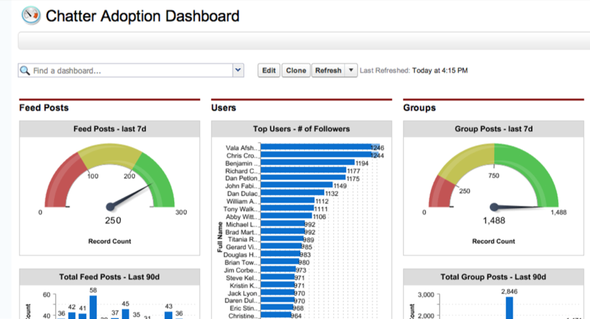
By Vala Afshar
DealerNet Services
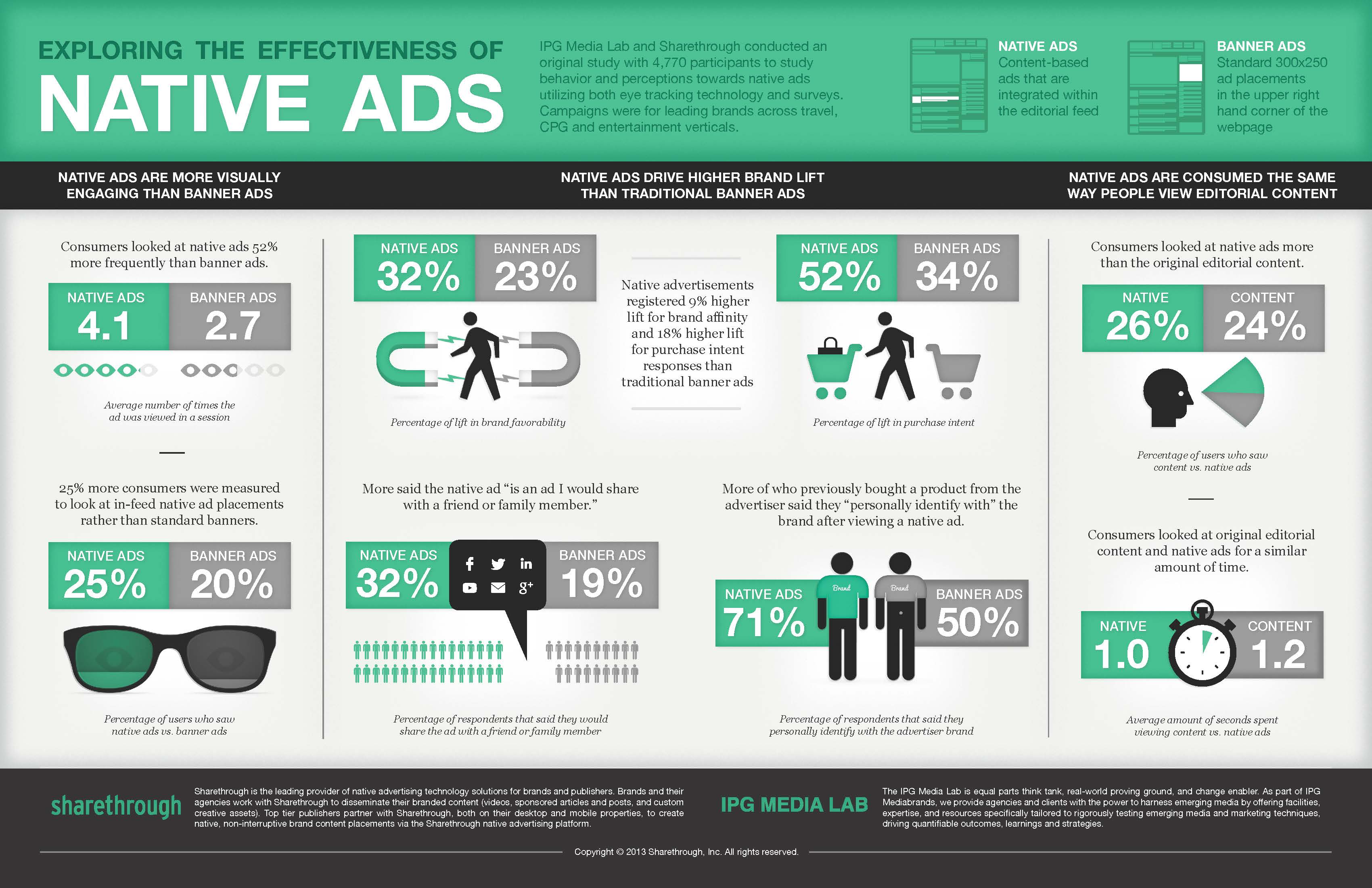
Definitions of native advertising still vary
Native advertising has seen a growing chorus of interest among publishers and ad buyers. Integrating sponsored content into digital channels has opened new doors for marketers to reach distracted consumers and provided publishers with new opportunities to generate ad revenue.
According to a June 2013 survey from the Online Publishers Association (OPA) and Radar Research, while many publishers may still be experimenting with how and what native advertising they will offer, most have already rolled out some native ad opportunities. Nearly three-quarters of polled US publishers said that they already offered native advertising on their site, and another 17% said they were considering offering it this year. Only 10% had no native ad plans of any kind.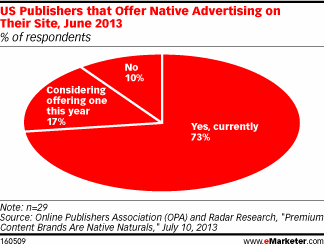
But even as more publishers roll out native advertising, there is still variation in how they think about and begin to define the new ad products. Nearly all publishers attested to the most essential definition of native advertising as “integration into the design of the publisher’s site and [an ad that] lives on the same domain.†And nearly nine out of 10 also said that native advertising was “content produced in conjunction with the advertiser, or by the advertiser, that runs within the editorial stream.†A slightly lesser 79% believed native advertising must be clearly delineated and labeled as such.
These may be crystallizing as the central tenets of native advertising.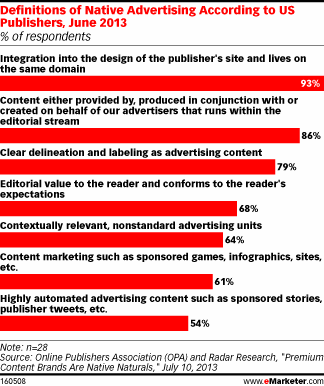
To evaluate their native ad campaigns, publishers said engagement was the leading metric marketers used, cited by 57% of respondents. That was followed by traffic, at 43%. Social sharing came in at one-third of respondents, indicating that while advertisers may want to get consumers sharing their native ad posts, this is not their No. 1 priority.
Market research company BIA/Kelsey estimated in April that this year, US native ad spending on social sites will reach $2.36 billion, or 38.9% of total US paid social ad expenditures. By 2017, social native ad spend will grow to $4.57 billion, and its share of social spending will inch up a few percentage points to 41.7%. But with native advertising reaching into so many digital channels besides social, this is likely far below the total outlays that will go toward native ads in all their different iterations.
eMarketer
DealerNet Services
 Brands, companies, and individuals -- I think it’s time for some real-talk about content and social media. Gary Vaynerchuk recently gave an interview about his decision to employ a full-time stalker (a.k.a “content personâ€) to chronicle, translate, and transcribe his every movement and remark into micro-content for various social media.
Brands, companies, and individuals -- I think it’s time for some real-talk about content and social media. Gary Vaynerchuk recently gave an interview about his decision to employ a full-time stalker (a.k.a “content personâ€) to chronicle, translate, and transcribe his every movement and remark into micro-content for various social media.While I respect Vaynerchuk’s incredible success and agree with his sentiment that micro-content and content in general is incredibly important to the future of business, I question whether encouraging brands and companies to develop this type of content is really what leaders in the social world should be doing.
This massively successful Slideshare presentation speaks to the already overwhelming amount of useless content we experience on a day to day basis. It states that “the single greatest threat to content marketing is content marketing.†The deluge of shoddy, slapped-together content and micro-content that content shops, farms, and agencies are churning out in an attempt to keep up with the growing desire for more and more media is actually what is making us (the collective number of people “listeningâ€) numb to content of quality.
I’m beginning to notice a “content double-take,†where readers are so glazed over scrolling through endless LOLcat updates and tweets about food that they almost (or sadly, sometime do) miss an incredibly important piece of content and have to scroll back to it after the few seconds it takes to sink in.
For instance how many reading actually know what’s happening in Turkey? Or that ExactTarget was acquired by Salesforce for billions of dollars? Or any equally important, business-specific update. I am totally guilty of this “double-take†predisposition and I’ve often missed opportunities to learn, grow as a consumer of content, and be informed about important, bottom-line impacting events. I’ve missed the chance to provide immense value to my community because of precisely the type of content Vaynerchuk is championing.
Do we, the brands and companies with the resources to develop consistent streams of content, want to build a culture of “fast food consumerism†around content and social media? Do we want to actively encourage QWERTY-vomit instead of meaningful, thoughtful insights that could actually benefit another human? Do we want to say without words that “fast and easy†holds more value than “thoughtful and creative?†Should the leading voices in this space really be creating and supporting this type of content?
I don’t think so.
We, as a collective, should be focusing on creating a smarter, more beneficial internet -- for everyone. Web media and the internet’s immense index of knowledge is fundamentally changing the way we learn and communicate across the world. It is the unspoken responsibility of those creating and pushing content (especially from high places) to not muck that up! A recent survey shows that 67.5% of professionals use social media to find and consume content for professional reasons every single day, and this percentage will only grow as more people around the world get connected to social networks.
It is our responsibility to do more, be better, and produce higher-quality resources than we did yesterday. People all over the world are looking to us, as leaders, for inspiration, guidance, and insight -- that they could follow in our footsteps and also be more than the sum of their parts. Failing to recognize this, or recognizing this fact and choosing to ignore it for the “easier†path, is negligent, insular, and selfish.
You may be saying to yourself “well, all that idealistic ‘we can make the world better’ sentiment is nice and all, but I really just care about my bottom line.†I respect your position as a business person but, unfortunately, the point that value and insight should be driving your content development still stands (see above, where 67.5% of professionals use social media to find and consume professional content every day). Diluting the landscape with meaningless drivel produces a more complex, chaotic content landscape that will actually make people pay attention to you less, which, at the end of the day, is the opposite of what we (as brands and business) want.
Let’s be real. More likely than not, if you are reading this, you are not in that top “1-5%,†which means you already have to go above and beyond to be heard through the noise on social media and the web in general. Do you really want to make this more difficult for yourself? Do you want to become a monotonous voice of constant, meaningless communication in a sea of identical monotonous voices or do you really want your message to shine and drive significant impact? Consider this: a recent poll of professionals on the Scoop.it platform presented data that one piece of high-quality content had brought in over $50,000 on average over the lifetime of that content.
A more organized and valuable internet benefits the world, our brands, and our future leaders for the long tail -- not just the short-term vision of the “top 1-5% of executives and social media personalities.†Random updates from the days of these top 1-5% won’t spark creativity or innovation -- the absolutely priceless insight and perspective which the positions of this top 1-5% afford them is what will inspire and help create the leaders of tomorrow. Brands and personalities should be known for who they are, what they stand for, and what they are best at -- not who can create the biggest firehose of social media data.
Who am I to say these things? No one, just a humble content person with a bigger vision for social media and content than tweets with no vowels. Someone who was inspired to do this work because of the incredible insights and sincerity I saw from the brands and online personalities that catapulted social media to its position in the ecosystem of the internet today.
I ask you, brands, companies, and individuals as a peer and fellow creator -- do you want to be remembered because you had amazing, beautiful, insightful things to give to the world or do you want to be remembered because you just wouldn’t shut up? The choice is yours.
ByClair Byrd
DealerNet Services
Most C-level Executives, CMO included, View “Social†as Media but…
Tags:
 Most C-level Executives, CMO included, view “Social†as media—but they don’t know how to interact with consumers there in a meaningful way. They want to buy CPMs or Likes—but don’t know what to do with them afterward.
Most C-level Executives, CMO included, view “Social†as media—but they don’t know how to interact with consumers there in a meaningful way. They want to buy CPMs or Likes—but don’t know what to do with them afterward.
CMO’s also make the mistake of assuming that the social audience has the same pain and passion points as their face-to-face or store audience. Most often that is not the case.
In order to get the real value out of Social, you must connect emotionally to the people who are there and find out what they’re looking for. CMOs are used to ads and campaigns, so that’s the place they gravitate, but even Facebook ads are only media buys. Ads are good for building initial likes, but they really are targeted to demographics just like any other ad.
Your mission is to go beyond that initial like and really get people excited about your brand, engage with you, buy from you, become a social advocate and sell for you. To do that you need to get into the heads of your social buyers.
So assign that as a singular goal to appropriate personnel on your team. Make it their mission to follow or friend your followers (not only on Facebook and Twitter, but everywhere online) and listen to their conversations. Their sole mission should be to pay attention to your social consumers. Find out what they like to talk about, the other brands they like, what their problems are–what makes them tick. That’s not a one-and-done task either… it’s ongoing.
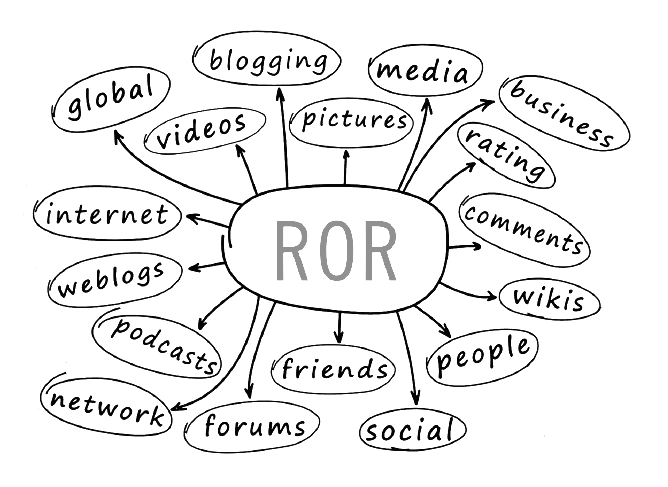
by Ted Rubin
DealerNet Services
 Have you noticed that more and more ads have been creeping into Google’s search results over the last few years? The result is that all the actual search results (known as “organic†results) are being pushed further and further down the page. The Problem In the screenshot below you can see the Google Ads highlighted in the red rectangles. This is what the Google results page looks like if I search for “Brisbane mechanic†on a laptop with a screen resolution of 1280×800, which is fairly common for 14″ or 15″ laptops (different screen resolutions will show more or less of the results page). As you can see, only two organic results show on the page without needing to scroll down. The content that shows at the top of the page without having to scroll down is known as being “above the fold“. In the same space there are SIX ads! Not to mention the ads get pride of place at the top of the screen, encouraging more people to click on them.
Have you noticed that more and more ads have been creeping into Google’s search results over the last few years? The result is that all the actual search results (known as “organic†results) are being pushed further and further down the page. The Problem In the screenshot below you can see the Google Ads highlighted in the red rectangles. This is what the Google results page looks like if I search for “Brisbane mechanic†on a laptop with a screen resolution of 1280×800, which is fairly common for 14″ or 15″ laptops (different screen resolutions will show more or less of the results page). As you can see, only two organic results show on the page without needing to scroll down. The content that shows at the top of the page without having to scroll down is known as being “above the fold“. In the same space there are SIX ads! Not to mention the ads get pride of place at the top of the screen, encouraging more people to click on them.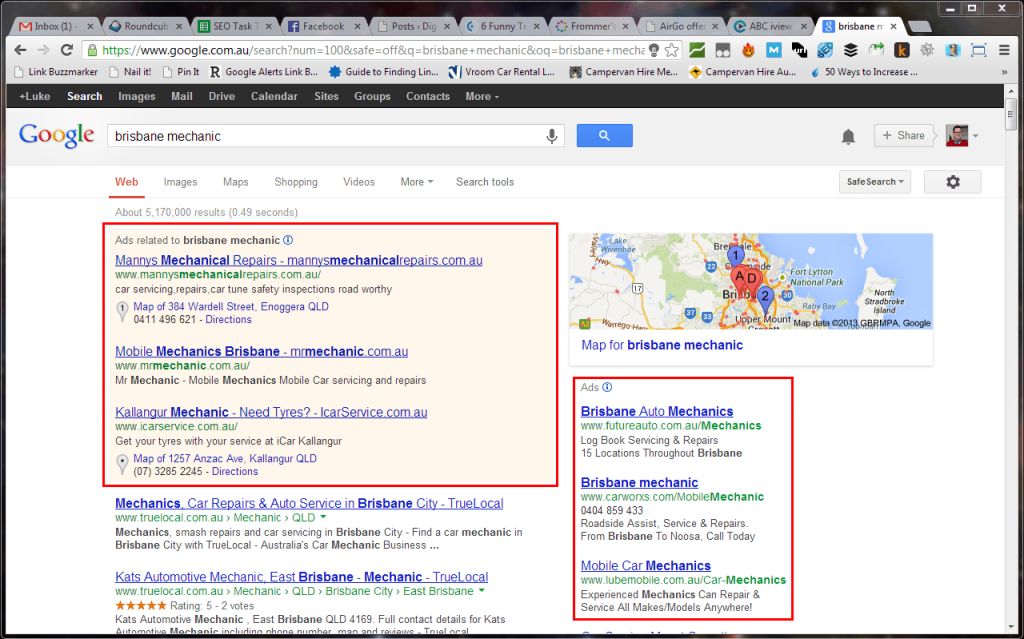
For some results there aren’t ANY organic results above the fold. That means everything you see after you search is advertising!
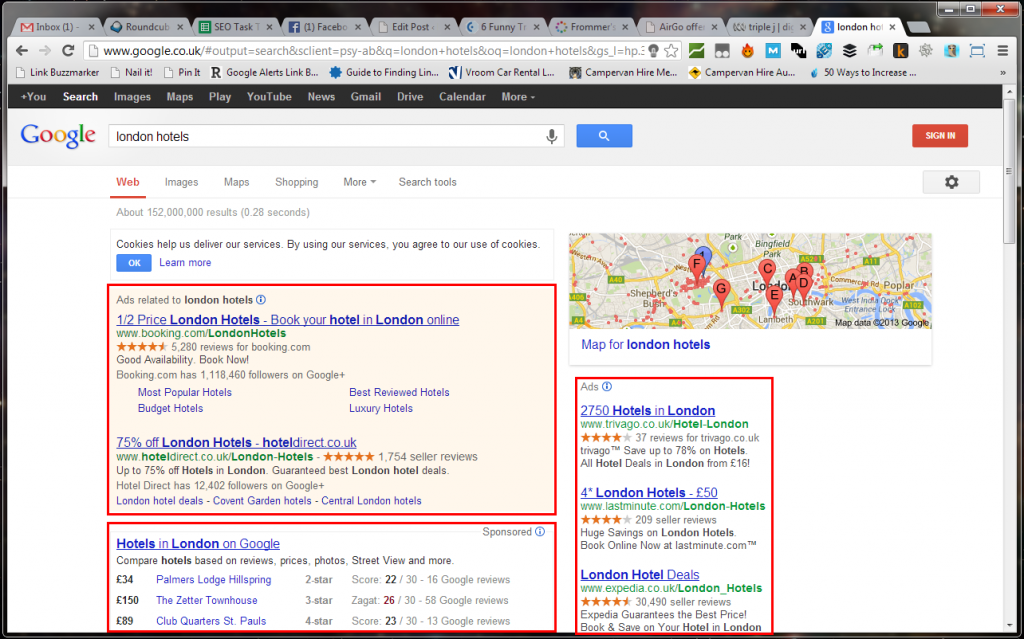
What Else Can I Do? “I want to rank number 1 on Google†is not a valid digital marketing strategy. Even less so now that the actual organic listings are being pushed so far down the page. The good news is there are so many other things that you can be doing to improve traffic to your website other than “traditional†SEO. Here are some ideas to get you started.
- Embrace social media. I don’t mean go and post funny cat photos on Facebook. I also don’t mean to go and buy a bunch of fake Facebook likes on Fiverr. I’m talking about actually being social. This gets right to the heart of what social media is about. Do some research and find out where your target market is active online – is it Facebook? Twitter? Pinterest? TripAdvisor? The answer will vary depending on your industry and the demographics of your target market. Once you know where your target market is, go and be social with them! Think about what that means. Is standing on a soap box yelling about your latest products or services “being social� No! Yet that’s exactly what most companies do on their social media accounts. What you should be doing instead is being helpful, getting involved in conversations and solving people’s problems.
- Become the authority for information or news on your topic. Seek out and write for relevant publications that may reach your target audience. A good way to do this is to look on websites like SourceBottle for journalists and bloggers that are seeking sources for their articles. Get in contact when they’re looking for something that you can help with, and you’ll often end up in a magazine, newspaper or on a website appearing as the expert on a certain topic, with a link to your website.
- One of the best ways to get extra exposure and PR is to network with other people in the industry, and with opinion leaders. Do the groundwork and build up these relationships and it will pay off in the longer term. If you need help with networking, I’d highly suggest reading Never Eat Alone by Keith Ferrazzi.
- Make the most of your existing customers and website traffic by getting them to sign up to regular e-mail newsletters. Once a month or quarter may be enough, depending on your website. Don’t send out updates just for the sake of it. Offer something interesting, insightful, newsworthy and/or funny. This will keep people coming back to your website and keep your brand front-of-mind.
- Find relevant blogs and comment on them. You’re not commenting for the power of the backlinks, but once again to help build your name as an expert and someone helpful. Be sure to use your name (not your company name) as this will make it much easier for people to relate to you, and you’ll come across as much more genuine and approachable.
- Go the extra mile for your customers. Word of mouth always has been (and still is) one of the most powerful forms of advertising you can get. Your customers will become advocates for your company (and website)!
- Branding is super important. Make sure your brand is consistent and easily recalled by customers. A nice clean website design is also important, as bad design can result in visitors clicking the back button straight away. Come up with a great tagline or business name and it will stick in people’s minds much longer. Guess who they’ll think of when they need the product or service that you provide?
by Luke Chapman
DealerNet Services
(Part 3) There Is More To This Content Marketing Than Just Clicking Publish
Tags:
 Why did this work so well?
Why did this work so well?
When someone is featured on another website, it can have a profound effect on their social following.
It shows that they are more of an authority on a subject because more people value their opinion.
The more times you’re featured and the more times your opinion is validated, the more of an authority that you will be perceived to be in the eyes of your followers.
Also, when you create an extremely valuable resource generally people are more inclined to share it because they know their followers will find value and appreciate the content being shared with them.
When someone is featured in an extremely valuable resource alongside some other big names, especially people that they look up to then they are compelled to share the content with their following and in some cases even go out of their way to share it more than they would with a regular mention.
I must warn you, not every person you include in a post like this will share and you will get varied results depending on the niche or industry that you operate in.
Â
What other types of content can you use?
Regular blog posts, interviews, group interviews, industry roundups and infographics all work well.
The rule of thumb here is that generally, the more people you involve in your content, the more potential people that might promote it.
Â
#3 – Build and maintain relationships with influencers and industry peers
A lot of people approach this blogging thing like it’s something you can do without any interaction or involving other people at all.
It used to be the case that people would just setup a blog, fire a load of rough content up and blast as many anchor text optimized links at their site as possible to rank in Google and then just sit on a beach somewhere without doing a thing – just sipping back mojitos while their bank account fills up with money.
For a time it worked and people made bank, we’re talking obscene amounts of money – but the problem that they have now is that Google has forced people into making effort, writing good content, building good links and generally treating our business the way it should be treated.
Whether your blogging to earn money, run an offline business or something else – the shortcuts don’t exist anymore.
Well, that’s not exactly true because there are certain verticals that are still dominated by spam, partly due to the fact that Google treats different industries differently, the ranking signals for one industry can differ drastically to another – but those that are still using nasty link building won’t get away with it for much longer.
Google left the door wide open and people saw an opportunity and for a lot of businesses it was a case of either use nasty link building tactics, rank and earn money or don’t use those tactics, don’t rank and don’t earn money.
People weren’t thinking of the big picture and it boils down to this – the user experience, whether it’s a slick site that gives you a great experience or a site that people simply find valuable and learn a lot from.
You need to get social, you need to connect and network.
Business owners have networked for years offline and used it to pass business to each other and generally help each other out – it’s worked great and it works great online too.
Â
Â
Â
And here’s a 5th – if you want to connect with bloggers directly and get a lot more shares on your posts then get involved by joining Triberr and be part of my Tribe.
BYÂ Adam Connell
Â
(Part 2) There Is More To This Content Marketing Than Just Clicking Publish
Tags:
 #2 – Feature or write about industry influencers
#2 – Feature or write about industry influencers
When you start any content marketing campaign, one of the first things that you should do is map out the influencers in your industry – think about the type of people that you follow and whose opinion that you value.
I recently published a group interview on my blog where I invited a number of industry experts to talk about how they build reader engagement with their audience. You can view the post here.
I started by inviting a number of influencers within the marketing industry to answer a number of questions on improving reader engagement – something that all of the people I asked did very well.
In the end I managed to publish responses from Seth Godin, Anita Campbell, Neil Patel and 30 other industry experts.
Â
What did I do to promote it?
I reached out to everyone that took part using social media sites such as Twitter and Google Plus – sites that would notify them that they’d been mentioned.
This was then followed up with an email to let the participants know that the post was live, where they could find it along with a call to action.
The call to action was to help share the post and vote for the post on BizSugar.
The post was then imported into my Triberr account – If you’ve not come across this before, it’s a platform that allows you to link up your Twitter profile (along with Facebook and Linkedin) and join tribes of like-minded bloggers, marketers or business owners that will see your content and get the opportunity to share it with their followers.
Â
What about the results?
In just over a day the post was the 2nd most popular post on BizSugar in June:

The post has gained quite a significant amount of traction on social media:

The post also earned some good links according to Ahrefs.com (Majestic shows more referring domains, but I prefer the graph in Ahrefs):
It also helped me get contributor of the week on BizSugar.com:

You can find the post here.
Continued Part 3:
http://onebigbroadcast.com/autospeakstraighttalk/view/287/_Part_3__There_Is_More_To_This_Content_Marketing_Than_Just_Clicking_Publish.html
http://dealernetservicesonline.biz
CALENDAR
CATEGORIES
TAGS
TWITTER POSTS
CALENDAR
- powered by
- One Big Broadcast
- creative by
- WebStager
© 2026 One Big Broadcast | All rights reserved




